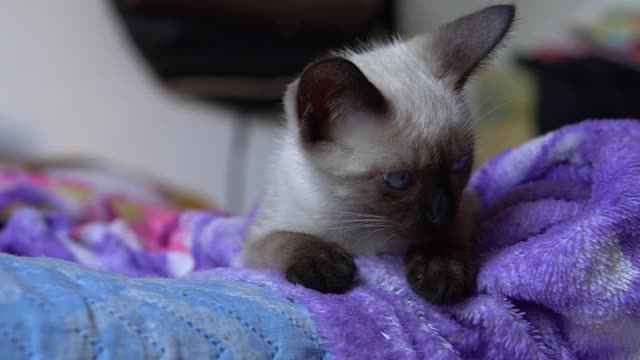Premium Only Content

The history of the domestic cat.
The history of the domestic cat.
Did you know that just 70 years ago, few cats lived entirely indoors? In fact, for more than 10,000 years, cats have lived outdoors, sharing their environment with birds and wild animals. Understanding cats' place in history and human evolution reveals how domestic cats have recently entered indoor environments and how millions of this species - feral cats - continue to live healthy outdoor lives today, as all domestic cats are biologically adapted to do.
Cats began their unique relationship with humans 10,000 to 12,000 years ago in the Fertile Crescent, the geographic region where some of the first developments of human civilization took place (encompassing modern parts of Western Asia). One of these developments was agriculture. As people abandoned their nomadic lifestyle and settled permanently to cultivate the land, the stored grain attracted rodents.
Taking advantage of this new and abundant food source, Middle Eastern feral cats, or felix silvestris lybica , attacked the rodents and decided to hang around these early cities, picking through the garbage that all human societies inevitably produce - just as feral cats do today.
Over thousands of years, a new species of cat eventually evolved that naturally made its home around people: felis catus . Today, pet, stray and feral cats belong to this species we call the domestic cat.
Cats formed a mutually beneficial relationship with people, and some scientists argue that cats domesticated themselves.Especially valued as rat catchers on ships, cats traveled with people around the world:A burial site in Cyprus provides the first archaeological evidence of humans and cats living side by side as early as 9,500 years ago. Cats must have been brought to the island intentionally by humans, In ancient Egypt, cats were worshiped, mummified and sometimes even dressed in gold jewelry to indicate the status of their owners, In 31 BC, Egypt became a province of the Roman Empire. Cats were introduced into Roman life, becoming truly widespread in Europe around the 4th century AD. 4 A cat skeleton from this period shows the shortened skull of today's domestic cats , Geoffrey Chaucer mentioned a cat door in The Canterbury Tales in the 1380s , From Europe, cats boarded ships for the Americas, supposedly accompanying Christopher Columbus, with the Jamestown settlers, and aboard the Mayflower , Cats continued their service as rat catchers throughout history, even serving as official employees of the United States Postal Service until 19th and early 20th century America , In the late 19th century , more Americans began keeping cats for their companionship as well as for their usefulness. The first cat show was held at Madison Square Garden in 1895. By the end of World War I, cats were commonly accepted as pets in the United States.
All the while, cats were allowed to move freely in and out of human homes - even President Calvin Coolidge's cat had free rein to roam to and from the White House during the 1920s. As Sam Stall, author of 100 Cats Who Changed Civilization and The Cat Owner's Manual , writes: "In Coolidge's time, no one thought of confining cats indoors - not even one belonging to the president of the United States.
Unlike dogs, which have undergone many physical changes since domestication and evolved to survive on an omnivorous diet, cats have not changed much and still need a high-protein diet. Before the development of refrigeration and canned cat food in the 20th century, feeding indoor cats that could not supplement their diets by hunting would have been impossible for most Americans, who could not afford extra fresh meat or fish.
In the thousands of years that cats have lived alongside people, indoor cats have only become common in the last 60 or 70 years - an insignificant amount of time on an evolutionary scale.
Throughout human history, cats have always lived and thrived outdoors. Only recently have we begun to introduce reproduction control, such as spaying and neutering, to bring them indoors. And also, to bring the outdoors to them: using canned food and litter boxes to satisfy the biological needs developed over thousands of years of living outdoors.
Although human civilization and domestic cats evolved side by side, the feral cat population was not created by humans. Cats have lived outdoors for a long time - they are not new to the environment.
-
 LIVE
LIVE
Man in America
5 hours ago“Summoning the Demon” — The AI Agenda Is FAR WORSE Than We Know w/ Kay Rubacek
628 watching -
 LIVE
LIVE
Tundra Tactical
3 hours ago🎯💥 The World’s Okayest Gun Show 🔫😂 | LIVE Tonight on Rumble!
278 watching -
 LIVE
LIVE
Mally_Mouse
22 hours ago🌶️ 🥵Spicy BITE Saturday!! 🥵🌶️- Let's Play: Tower Unite!
466 watching -
 58:59
58:59
MattMorseTV
3 hours ago $0.53 earned🔴Trump just BROKE Newsom.🔴
32.4K31 -
 18:14
18:14
Her Patriot Voice
3 hours agoWho Is WORSE for NYC: Trump Girl or Socialist?
10K21 -
 LIVE
LIVE
SavageJayGatsby
3 hours agoSpicy Saturday with Mally! | Road to 100 | $300 Weekly Goal for Spicy Bites!
1,471 watching -
 LIVE
LIVE
FomoTV
5 hours ago🚨 Swamp Theater: FBI Raids Bolton 🕵 Still NO Epstein Files, Trump's Troops & the Red Heifer Hoax 🐂 | Fomocast 08.23.25
59 watching -
 6:04:40
6:04:40
Akademiks
8 hours agoRoc Nation & Meg Thee Stallion did a 7 HOUR Deposition with me. Drake Secret Kid Finally Revealed.
35.5K1 -
 24:19
24:19
Stephen Gardner
4 hours ago🚨BREAKING: FBI Raid of John Bolton’s House Reveals THIS!
39.4K97 -
 8:31
8:31
MattMorseTV
6 hours ago $0.93 earnedTexas just did the IMPOSSIBLE.
35.2K57